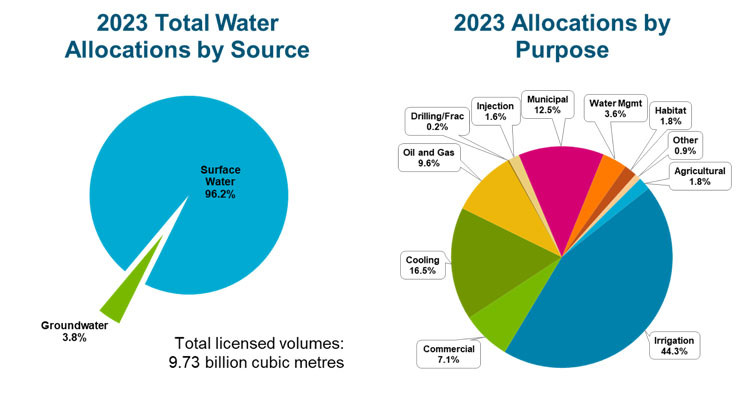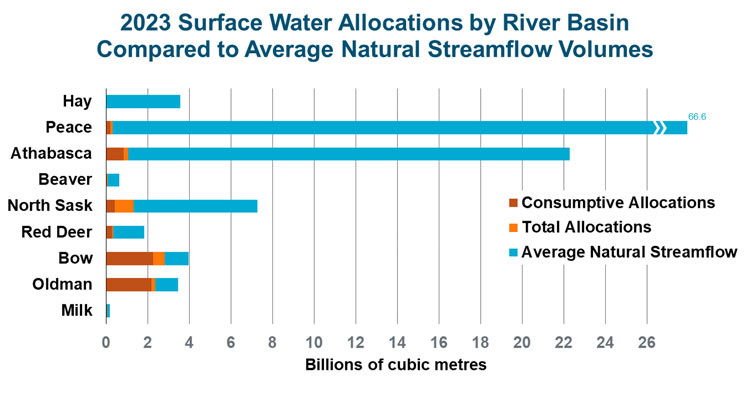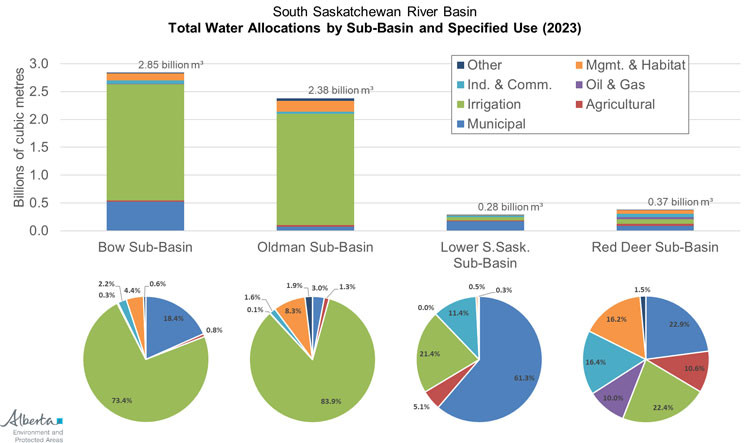Government mail service may be affected by the Canada Post labour disruption. Learn about how critical government mail will be handled.
Water allocation in Alberta
Water licence holders in Alberta must specify the volume they plan to withdraw and purpose for which it will be used. This information:
- helps the Government of Alberta track changes in water allocations over time
- supports an informed response to drought and water shortage situations
Provincewide water use
Source and purpose
Most water used by Albertans and various industries is drawn from surface water sources, although groundwater is also available for allocation.

Table 1. 2023 Total water allocations by source
| Source | Water allocation (%) |
|---|---|
| Surface water | 96.2 |
| Groundwater | 3.8 |
| Total licensed volumes: 9.73 billion cubic metres | |
Table 2. 2023 Total water allocations by purpose
| Purpose | Water allocation (%) |
|---|---|
| Irrigation | 44.3 |
| Cooling | 16.5 |
| Municipal | 12.5 |
| Oil and gas | 9.6 |
| Commercial | 7.1 |
| Water management | 3.6 |
| Agricultural | 1.8 |
| Habitat | 1.8 |
| Injection | 1.6 |
| Other | 0.9 |
| Drilling/fracking | 0.2 |
| Total licensed volumes: 9.73 billion cubic metres | |
Consumptive surface water allocations by river basin
Not all water withdrawn is permanently removed from our river systems. The Government of Alberta tracks consumptive and non-consumptive use of water so we know how much of the water allocated will eventually be treated and returned to our environment.
Consumptive water use is any type of water use that reduces or eliminates the overall volume of water available for other uses. For example, watering your lawn is considered consumptive, because the water used is retained by the grass to promote growth, with a certain percentage evaporating into the air.
Non-consumptive water use generally refers to water used in such a way that it is available for other uses. Many indoor water uses are considered non-consumptive, such as running your dishwasher or taking a shower, because this water flows back into treatment systems that eventually return the water to primary sources.

South Saskatchewan River Basin
With nearly 680,000 hectares of irrigated land, Alberta has the largest irrigated area in Canada. More than 80% of this area is in 13 irrigation districts located in the South Saskatchewan River Basin. Because of this, the mix of water use in southern Alberta is different than it is in other areas of the province.

Table 3. 2023 South Saskatchewan River Basin total water allocations by sub-basin and specified use
| Use type | Bow (%) | Oldman (%) | Lower S. Sask (%) | Red Deer (%) |
|---|---|---|---|---|
| Agricultural | 0.8 | 1.3 | 5.1 | 10.6 |
| Industry and commercial | 2.2 | 1.6 | 11.4 | 16.4 |
| Irrigation | 73.4 | 83.5 | 21.4 | 22.4 |
| Management and habitat | 4.4 | 8.3 | 0.5 | 16.2 |
| Municipal | 18.4 | 3.0 | 61.3 | 22.9 |
| Oil and gas | 0.3 | 0.1 | 0.0 | 10.0 |
| Other | 0.6 | 1.9 | 0.3 | 1.5 |
Water apportionment
Alberta is required to share water with neighbouring jurisdictions. Our transboundary water agreements outline Alberta’s obligations and entitlements for shared waters with British Columbia, the Northwest Territories, Saskatchewan and the United States.
We work cooperatively with our neighbours to ensure our province both receives and passes along the appropriate amount of water.
Three transboundary water agreements are in place for waters flowing through Alberta:
Contact
Connect with Environment and Protected Areas’ Outreach Services:
Hours: 8:15 am to 4:30 pm (open Monday to Friday, closed statutory holidays)
Toll free: 310-3773 (in Alberta)
Email: [email protected]